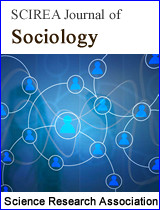Self in relation with the Other and the Earth in Nora K. Jemisin’s The Broken Earth
DOI: 10.54647/sociology84876 72 Downloads 13264 Views
Author(s)
Abstract
The trilogy of The Broken Earth, written by Nora K. Jemisin, demonstrates layers of themes among which self-in-relation with the other and the earth is a considerable subject for the rescue of the real world. Relational self was first theorized by the forerunners of socio-ecological feminists such as Val Plumwood and Greta Gaard. It gives an explanation of non-instrumental manner and continuous relationship between self (human) and the other (other humans, other genders, other races, other species, the natural world, and the earth). Sense of altruism, empathy for the other and responsibility for ecosystem, relational identity, protection of the other for the protection of self, heroism, self-sacrifice, and care for the other are significant characteristics of self-in-relational protagonists who are humans, super-humans, and non-humans in the trilogy. Eco-crises of the fantasy planet are the outcome of anthropocentrist and speciesist humans’ abuse of natural resources and other species of humans called Orogene. In spite of volcanic eruptions, earthquakes, long winters and, unbalanced Father Earth caused by the cruel humans in two similar periods of time, American science fantasy author projects idealistic self-in-relational people whose devotions result in a justice-based community and the revival of the planet. Central characters’ relations to Father Earth are appropriate embodiment of the ideal relation of species to the earth and self-geology by which they find Father Earth an animated and active being similar to the humans. They come to the point that social environmental justice and interspecies justice are the matter of survival in the end of the world. Integration and solidarity among various races and species overcome domineering humans and renovate the damaged earth. Self-in-relational characters and some other individuals create a moral space among all species and a connection between species and Father Earth, identifying other species and the earth as their own relative.
Keywords
Altruism, Anthropocentrist and Speciesist Humans, Justice-based Community, Non-instrumental Manner, Self-in-relation with the Other and the Earth, Social Ecological Feminists
Cite this paper
Shohreh Haji Mola Hosein,
Self in relation with the Other and the Earth in Nora K. Jemisin’s The Broken Earth
, SCIREA Journal of Sociology.
Volume 6, Issue 4, August 2022 | PP. 252-272.
10.54647/sociology84876
References
| [ 1 ] | Campbell, Joseph. The Hero with A Thousand Faces. Fontana Press, 1993. |
| [ 2 ] | Daly, Erin. “Constitutional Protection for Environmental Right”. International Journal of Peace Studies, vol. 17, no. 2, 2012, pp.71-80. JSTOR, www.jstor.org/stable/41853036. Accessed 7 March 2016. |
| [ 3 ] | Gaard, Greta and Patrick D. Murphy. “A Dialogue on the Role and Place of Literary Criticism within Ecofeminism”. ISLE: Interdisciplinary Studies in Literature and Environment, vol.3, no.1, 1996, PP. 1-6. doi.org/10.1093/isle/3.1.1. |
| [ 4 ] | ---. Ecological Politics: Ecofeminists and the Green. Temple UP, 1998. |
| [ 5 ] | ---. “New Directions for Ecofeminism: Toward a More Feminist Ecocriticism”. ISLE: Interdisciplinary Studies in Literature and Environment, vol.17, no. 4, 2010, pp. 643-665. doi.org/10.1093/isle/isq108. |
| [ 6 ] | Goralnik, Lissy and Michael P. Nelson. “Anthropocentrism”. Encyclopedia of Applied Ethics, edited by Ruth Chadwick, 2nd ed., Academic Press, 2012, pp. 145-155. |
| [ 7 ] | Jemisin, Nora K. The Fifth Season. E-book, Green Ronin, 2015. |
| [ 8 ] | ---. The Obelisk Gate. E-book, Green Ronin, 2016. |
| [ 9 ] | ---. The Stone Sky. E-book, Green Ronin, 2017. |
| [ 10 ] | Kirk, Gwyn. “Eco Feminism and Environmental Justice: Bridges across Gender, Race, and Class”. A journal of women studies, Intersection of Feminist and Environmentalisms, vol.18, no. 2, 1997, pp.2-20. www.jstor.org/stable/3346962. Accessed 11December 2010. |
| [ 11 ] | Mallory, Chaone. “Val Plumwwood and Ecofeminist Political Solidarity”. Ethics and the Environment, vol. 14, no. 2, 2009, pp. 3-19. JSTOR, www.jstor.org/stable/10.2979/ETE.2009.14.2.3. Accessed 21June 2014. |
| [ 12 ] | Plumwood, Val. Feminism and the Mastery of Nature. Routledge, 1993. |
| [ 13 ] | ---. “Integrating Ethical Frameworks for Animals, Humans, and Nature: A Critical Feminist Eco-socialist Analysis”. Indiana, Indiana University Press, Ethics and the Environment, vol. 5, no.2, pp. 285-322. JSTOR, www.jstor.org/stable/40338997. Accessed 18 November 2015. |
| [ 14 ] | ---. “Nature, Self, and Gender: Feminism, Environmental Philosophy, and the Critique of Rationalism”. Hypatia, Ecological Feminism, vol.6, no.1, 1991, pp. 3-27. JSTOR, www.jstor.org/stable/3810030. Accessed 15 September 2016. |
| [ 15 ] | Tiwari, Rajnaraya R. “Gandhi as an Environmentalist”. The Indian Journal of Medical Research, vol. 149, no. 1, 2019, pp. 141-143, doi: 10. 4103 / 0971 -5916.251671. |

